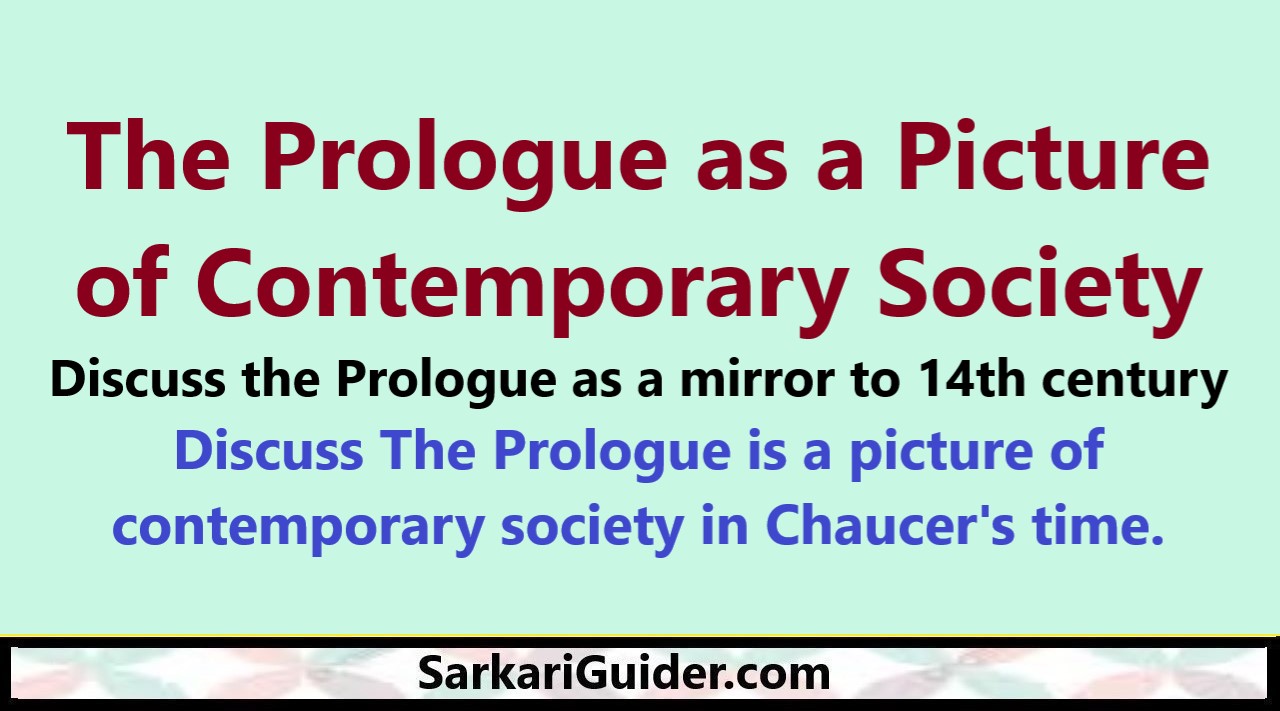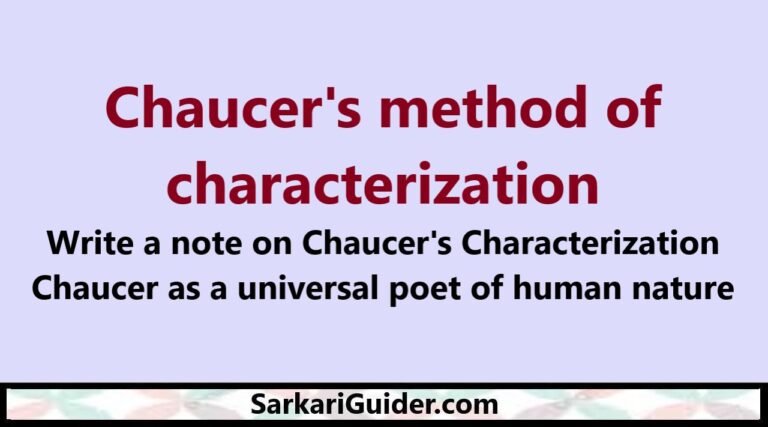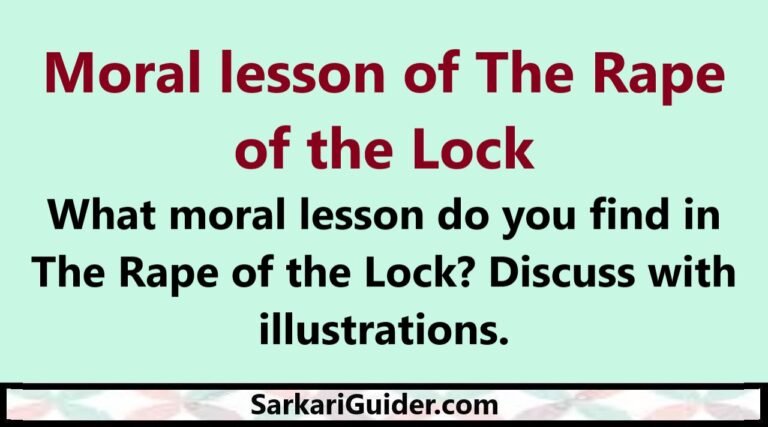The Prologue as a Picture of Contemporary Society | Discuss the Prologue as a mirror to 14th century | Discuss The Prologue is a picture of contemporary society in Chaucer’s time.

The Prologue as a Picture of Contemporary Society | Discuss the Prologue as a mirror to 14th century | Discuss The Prologue is a picture of contemporary society in Chaucer’s time.
The Prologue as a Picture of Contemporary Society
An Artistic and Realistic picture of Society –
The Prologue to the Canterbury Tales has been universally acclaimed as a fine picture of the fourteenth century England. It artistrically holds up a mirror to Chaucer’s contemporary society. The Canterbury pilgrims come from all walks of life and represent almost every class of English society in the fourteenth century. Chaucer has excluded only the very highest and the very lowest fringes of society. Perhaps they were unlikely and the lowest class of labourers excluded, the thirty pilgrims represent the whole range of medieval English society. A similar Picture of English society, and perhaps the first of its kind, was presented by William Langland in the Visio of Piers the Plowman. But that was rude and inartistic, being more of a social and religious document than a poem and a work of art. Its method was that of dram allegory. Langland attacked the vicious evils of his society with the reformer’s zeal, but Chaucer surveyed that panorama of the corrupt society with amused tolerance. Moreover, he discarded the intastic world of dream and allegory. He painted his society in a realistic manner and with great artistic detachment. These make his poem a far greater work of art and a no less valuable social document than the Vision of Piers the Plowman.
The Representative Character of the Prologue:
The Prologue, though not schematically representative of the fourteenth century English society, covers nevertheless a wide range of it. Almost all the main social elements are included in it. The institution of Chivalry is represented by the knight and his son, the squire. The Yeoman represents the newly emerging fighting class. The rising middle classes are well exemplified by the London Merchant, the five tradesman, the Host and the London Cook and Manciple. The landed gentry and the agricultural labourers are represented by the miller, the reeve, the franklin and the ploughman. Monestic orders are exemplified by the Monk, the Prioress, the Nun, the Friar and the Pardoner. Secular clergy is represented by the good Person and the Summoner. Liberal profession are represented by the Doctor of Physic, the Man of Law, the Clerk of Oxford and the poet himself. From the Provinces come the craftsmen, the Harberdasher the Carpenter, the Weaver, the Dyer, the Tapicer and the wife of Bath.
Thus all the main social elements of medieval English society are represented well enough by the thirty pilgrims painted in the prologue. The religious motive of the pilgrimage made it possible for Chaucer to bring together on a friendly footing persons from different stratas of society. Some of these pilgrims, we are told, were based on reel models. Chaucer’s contemporaries would have easily identified them. This realistic basis of pilgrims made them of immediate interest to Chaucer’s contemporaries.
Some Basic objections to the Realistic Scheme of the Prologue –
In the first place, it has been pointed out that by rules of Church, the pilgrims were supposed to proceed to their intended shrine in an ash coloured, grey and humble cloak, leaving aside all their wanted costumes and finery. But Chaucer has presented his pilgrims in their best costumes and finery. How could Chaucer ignore this basic fact about religious pilgrimages? An explanation to this question comes from the laxity of Church rules in Chaucer’s times. We know from various sources that pilgrimages were taken more in the spirit of a holiday than of a spiritual prescription for redemption. A pilgrimage was regarded as a popular excursion during the middle ages, “The insincere found a far too easy “penance,” the light- minded were given fatal opportunity for dalliance, the profligate and the thief had broad, new fields for wickedness.” (Muriel Bowden) Chaucer was fully aware of the many ills connected with these pilgrimages. We lerarn from other social and religious documents of the age that “woman visit monasteries far from their homes, and there they pay court to Venus instead of to a saint.” Chaucer has shown us both sides of the picture. Some of his pilgrims show “falsnesse”, “leccharye” and “drunkennesse”, and on the other hand some are undertaking this journey with genuine devoutness. Therefot, there is nothing unreal or untrue in Chaucer’s scheme of presenting his pilgrims in their gayest moods and finest liveries.
The second objection put forward against the realism of the scheme is that we are told by Chaucer that the peocesion of the Canterbury pilgrims was led out by the Miller, playing upon a big pipe. Are we to believe that the knight of the noble blood, and the nun of a noble descent, would design to follow such a lude companion? A suitable explanation to this objection may be found in the nature of the scheme itself. An account of such processions was very common during Chaucer’s days. The pilgrims went on singing and dancing and making a lot of noise by the roadside. The common consciousness of their sins and need for redemption obliterate all social distinctions and the high and the low travelled on equal footing in this democracy of pilgrimage. Hence there is nothing objectionable if the procession is led by the Miller.
The Social and Political Upheavals of the time-
A more serious objection questioning the validity of the Prologue as a true and comprehensive picture of Chaucer’s as in that some of the most important events of the fourteenth century which had shaken the entire foundation of mediaeval society are not referred to at all by Chaucer. The main events were
(1) The Anglo-French Wars
(2) The Rise of English Nationalism
(3) Black Death
(4) The Peasant’s Revolt
(5) Wyclifite Movement or Lollardism
(6) The struggle of the House of Lancaster against Richard II
culminating in the latter’s deposition.
(7) Democratization of England.
Now most of these events do not find even the remotest echo in Chaucer’s poem. The political history of the age tells us that it was a period of great social and political upheavals. When the times were so hectic and disturbed, why would Chaucer like to give us the impression that the English men had no other concern but to put on their best dresses and gayest moods and to go on a pilgrimage in the spirit of a perfect holiday? Various explanation have been put forward in this connection. Let us examine them one by one.
The realism of the historian and that of the artist are of two different kinds. The historian has to record all those important events which are happening on the surface of life. The literary artist, however, cannot involve himself in those surface events because they are of an ephemeral nature. Even the most important historical events his main concern, his work would soon become incomprehensive because of the obscure allusions in which it will abound. Literature must have a universal and abiding appeal and therefore, it must have the wisdom to eschew reference to mere historical events. It must penetrate into the depths of life and the baris of human character so as to ensure an everlasting appeal and permanence of interest. Chaucer was an artist first and foremost. As has been pointed out by Muriel Bowden, “The most important reason for Chaucer’s silence about political affairs and national event undoubtedly lies in the very nature of his genius, the poet’s magnificent Human Comedy is the more human it is “drenched in life”, as John Livingston Lowes has said in that it is without the immediate, and is concerned with the universal and the timeless.”
Furthermore, Chaucer the artist must have realized that the sphere of the political and historical events, even at the time of their happening, was quite limited. How few people are affected in their day to day life by what are called events of national importance Generally these events are the main concern of the people who are at the helm of state affairs. The vast majority of the people doesn’t bother about them. Chaucer knew this secret and in depicting English life of the fourteenth century he did not concern himself with what might have been the concern of a very few but with that which sustained the nation in its everyday existence. That is why Chaucer has caught the spirit of his age which even the most scrupulous historians would not be able to recapture.
Conclusion-
To quote Legouis, “He is….. truly the social chronicler of England at the end of fourteenth century…. What he was given is a direct transcription of daily life, taken in the very act, as it were, and in its most familiar aspects. Chaucer’s work is the most precions document for whoever wishes to evoke a picture of life as it then was, precisely because he had no regard for the conventional hierarchy of men and events, because he went straight to the most commonplace among them and purposely selected these as being more comprehensively representative.”
English – Important links
- Essay on the Hellenic and Hebraic elements in “Paradise Lost” | Discuss, Milton was a child of both of the Renaissance and the Reformation.
- Chaucer’s Humanism | Discuss Chaucer’s Humanism
Disclaimer: sarkariguider.com is created only for the purpose of education and knowledge. sarkariguider.com does not own these book/materials, neither created nor scanned. We provide the links which is already available on the internet. For any quarries, Disclaimer are requested to kindly contact us, we assured you we will do our best. We do not support piracy, this copy was provided for students who are financially troubled but deserving to learn. If in any way it violates the law or there is a problem, please mail us- [email protected]







